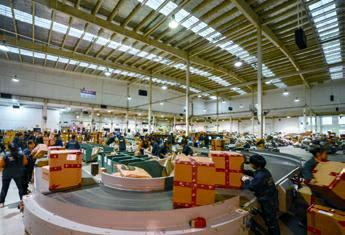LOOKING TO THE TWO SESSIONS
2014-03-18ByMeiXinyu
By+Mei+Xinyu

restructuring. The previous growth model created some astonishing economic miracles, but domestic demand, finance and environmental pollution are increasingly restricting economic growth.
Outside China, the world economy has entered a low-growth period that may continue for 10 years or longer. The United States is tapering its quantitative easing policy, and some emerging economies, including Russia, India, Brazil, South Africa, Turkey, Indonesia and Argentina, are on the verge of, or have already fallen into, monetary and financial crisis. Economic fluctuations in several emerging economies are likely to cause social unrest, hence replaying the debt crisis that swept developing countries, the former Soviet Union and Eastern Europe in the 1980s. Emerging economies have contributed to half of Chinas foreign trade, therefore the crisis in these countries will affect Chinas capital flow and exchange rate.
With such a scenario in mind, the 2014 sessions of the National Peoples Congress and the Chinese Peoples Political Consultative Conference will be held, with economic, reform, anti-corruption and environmental protection issues major topics. In the present world of complexities, we need to take the overall situation into account in order to solve all these problems. China must ensure social stability and sustainable economic growth. To achieve this, several measures should be taken.
Firstly, an attempt should be made to reduce the impact on legitimate consumption and service sectors coming from the anticorruption campaign. The government must properly increase salaries of government employees so as to obtain more public support for the anti-corruption campaign and to establish sustainable systems for clean government.
Secondly, it is important to avoid excessively reducing investment ratio, excessively increasing consumption and excessively reducing existing production capacity and foreign trade during the process of the transformation of our economic growth model. This situation has been replicated in many developed and developing countries, and China should steer clear of making the same mistakes. For example, the issue of whether or not production capacity is excessive must be reviewed by considering the whole global market and a complete economic cycle, instead of only considering the domestic market and stagnation periods.
The readjustment of our economic growth model must be carried out with cautious and thorough consideration and the avoidance of overcorrection. The growth model of being highly dependent on domestic demand has been adopted by the United States and Europe as well as many emerging economies such as India. Over the past decade, this model has received a significant amount of acclaim, and many believe this should be the direction of Chinas economic restructuring.endprint
However, we must recognize that, in an open global economic system, excessive dependence on domestic demand as well as high spending rates and low investment rates are exactly the reasons why emerging economies are not stable and sustainable. This is because the continual deficits in the trade in goods and current account inherent in the model carry with them great potential risks for economic and financial crisis, which will inevitably tamper with the stability of a countrys currency. National savings and investment are always sources of sustainable economic growth.
Economic powers holding the core status of the international monetary system can certainly endure current account deficits for a long time, but continual deficits in the current accounts of these emerging economies will definitely lead to economic and financial crisis. Highly praising the domestic demand-driven model in India and excessive criticizing of the adverse impact of Chinas trade surplus actually fall into the trap of accepting some longstanding mistaken ideas regarding international liquidity.
In the last 10 years, the international payment risks have been largely ignored, but the adverse impact of continual trade surplus and huge foreign exchange reserves were exaggerated. The most important reason for this is that the total international liquidity volume has been growing remarkably on the whole. According to my estimations, in 1995, the global foreign exchange reserves accounted for 26.3 percent of total imports by all world countries. The proportion rose to 28.9 percent in 2000 and 60.2 percent in 2012. However, such a huge international liquidity is to a great degree unevenly distributed among different economies. Therefore, the speedily rising proportion of foreign exchange reserves against total imports by all countries does not mean the risks of international payment crisis have diminished. Considering that global capital flow is growing even faster during this period, the risk of an international payment crisis should never be ignored.
When its economic growth is dropping drastically or is likely to drop, a country with a current account surplus that is highly dependent on exports usually will not face conflicts regarding policy targets and does not need to worry about measures such as curbing inflation. However, a country with a current account deficit will lose this advantage. For this reason, different emerging economies will have varying degrees of freedom when it comes to choosing policies that ensure stable economic growth, widening the gap among different emerging economies in development trends.endprint
While hazy weather is sweeping the country, environmental protection topics will certainly attract great attention. However, we must be very prudent and even vigilant when faced with propositions to reduce coal consumption rapidly and drastically. This is because technology for the clean utilization of coal has made marked progress, and emission standards can be sufficiently met by shutting down small power plants and supporting their larger counterparts.
Moreover, the proportion of coal in the worlds total energy consumption has increased nearly 2 percentage points in the past decade, and developed countries such as the United States and Germany are no exception. As the worlds largest manufacturer, trading nation and power generator, China produces and consumes half of the coal in the whole world. If China blindly reduces coal consumption, it will just offer a good opportunity for oil and natural gas exporting countries.
Anti-corruption is undoubtedly the topic in the past year that has aroused the most attention and extensive public support. But every coin has two sides, and the anti-corruption campaign could also have some negative side effects on the legitimate consumption and service sectors. If policymakers are inattentive and act rashly, this impact could potentially be disastrous and even damage supporters of the anti-corruption campaign.
For example, while a crackdown on the sex trade in Dongguan, Guangdong Province is correct, the legitimate industries and the overall image of the city must not be tarnished.
Dongguan is a leading manufacturing city in the world and an important international trade city. With more than 11,000 manufacturing companies and numerous trading companies, Dongguan inhabits a very important global position in the industries which manufacture IT products, furniture and other commodities. In 2013, the trade volume of Dongguan-originated products totaled $169.03 billion, rising 6.5 percent year on year, even surpassing the foreign trade volume of most world countries.
In the course of the crackdown on the sex trade, Dongguans image has become something of a laughing stock. Whether the jibes aimed at the city were for fun or ill-willed in intention, Dongguans real economy has been unfortunately affected. Anti-corruption campaigners would do well to take heed of this citys example going forward.endprint
